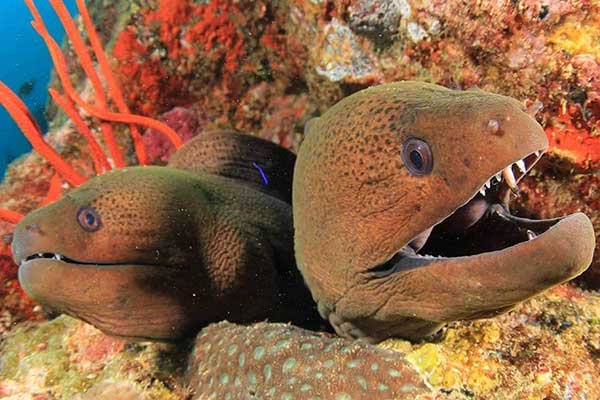Have you ever felt that someone was watching you, during a dive? Only to spot the toothy grin of a Moray eel sticking out of a hole? Perhaps you did not feel much sympathy for this creature. Still, Moray eels are some of the ocean’s most intriguing predators, and they deserve to be loved!
With their sleek bodies, rhythmic mouth movements, and surprising behaviors, moray eels can capture the curiosity of some divers, and fear in others. But there’s much more to morays than meets the eye. Let’s take a closer look at these mysterious reef dwellers and explore what makes them so unique.
What Is a Moray eel?
Moray eels are part of the family Muraenidae, which includes over 200 different species. They are not true eels, like freshwater eels, but a group of elongated fish adapted for life in reef environments. Morays are most often seen tucked into cracks and holes in the reef, with just their heads sticking out.
Most morays live in tropical and subtropical oceans, and many species call coral reefs, rocky ledges, or wrecks home. Their range includes the warm waters of Thailand, Indonesia, and the Philippines, where divers can spot several species on nearly every dive.
Common species
Moray eels come in a stunning variety of shapes, sizes, and colors. Here are some of the most common and some visually striking species:
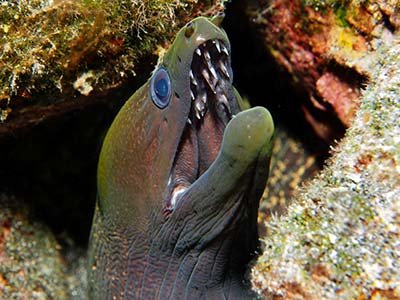
Undulated Moray (Gymnothorax undulatus)
The Undulated Moray is medium-sized, growing up to 1.5 meters, and has a beautiful greenish-yellow body marked with dark, wave-like or zigzag patterns—hence the name “undulated.” Its bright yellow eyes and slender head give it a distinct appearance. It’s often seen poking out of crevices on coral reefs and is known for being more defensive if disturbed. Though not aggressive by nature, it’s best admired from a respectful distance.
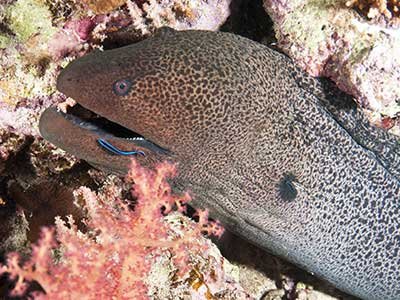
Giant Moray (Gymnothorax javanicus)
The Giant Moray is the largest moray eel in the region, often growing up to 3 meters long. It has a thick, muscular body covered in dark brown or black spots that become more leopard-like with age. Its eyes are usually yellowish to amber.
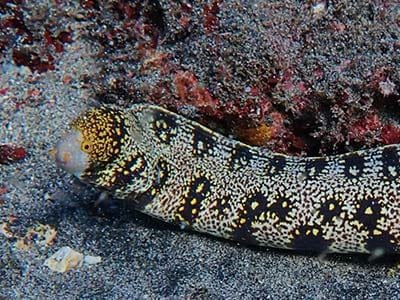
Snowflake (Clouded) Moray (Echidna nebulosa)
This medium-sized Moray has a white body covered with irregular black or dark brown blotches resembling snowflakes. It has a rounded snout and blunt teeth for crushing crustaceans. Its eyes are a striking bright yellow, making it easier to spot against its pale body.
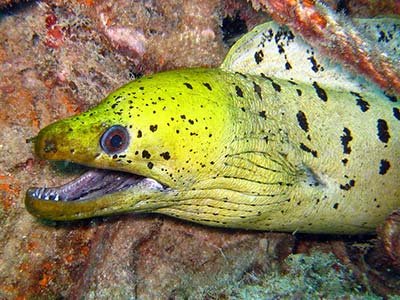
Fimbriated (Spot-Face) Moray (Gymnothorax fimbriatus)
The Fimbriated Moray has a pale yellow to cream-colored body scattered with small black spots, and a greenish-yellow head. It typically grows to around 80 cm and has yellow-green eyes. This eel is often found in lagoon reefs and is more active during dusk and dawn.
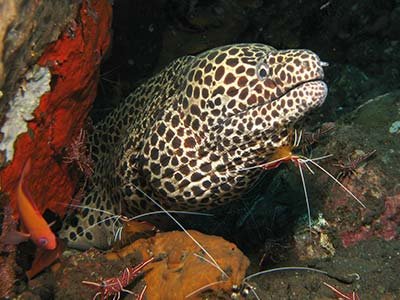
Honeycomb Moray (Gymnothorax favagineus)
This large Moray eel is easily recognized by its bold black-and-white honeycomb pattern. It can grow up to 3 meters long and has pale yellow to amber eyes. The Honeycomb Moray prefers outer reef slopes and deeper drop-offs, and is often spotted with just its head peeking from a hiding spot.
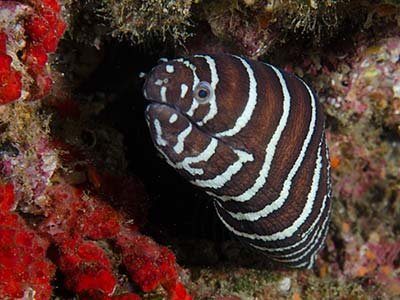
Barred (Zebra) Moray (Echidna polyzona)
Also known as the Zebra Moray, this species has a slender body with alternating dark and light vertical bands. It reaches about 1 meter in length and has dark brown or black eyes. Unlike other Morays, it is shy and tends to stay well-hidden during the day, emerging to hunt at night.
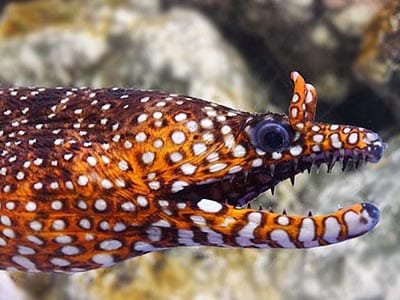
Dragon (or Panther ) Moray (Enchelycore pardalis)
The Dragon Moray is one of the most visually striking and rare Moray eels in Southeast Asia. It has a colorful and bizarre appearance, with a white to cream body covered in orange and brown leopard-like spots, and bold dark bands across its head.
Dragon Morays usually reach about 90 cm in length and prefer hiding in caves and cracks in deeper reef slopes, lava formations, or rocky coastlines. While more common in Japan and Hawaii, they can occasionally be found in parts of Indonesia and the Philippines, especially in areas with rich volcanic reef systems.
Because of their elusive nature and deep habitat, they are rarely seen by casual divers, but unforgettable when spotted.
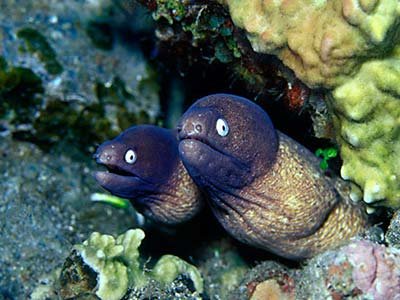
White-Eyed Moray (Gymnothorax thyrsoideus)
This small to medium-sized Moray is easy to identify by its distinct bright white eyes, which stand out sharply against its usually dark brown to greyish body.
The white-eyed Moray typically grows up to 70–80 cm and is often seen in groups or clusters, hiding under rocks or coral slabs. It’s one of the few moray eels that can be spotted during the day out in the open. Despite its intimidating stare, it’s generally shy and not aggressive toward divers.
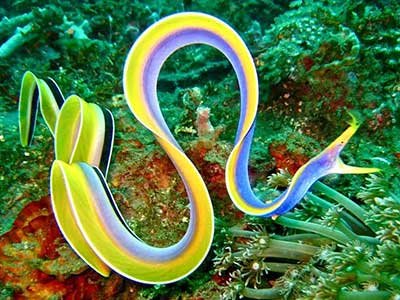
Ribbon Eel (Rhinomuraena quaesita)
The Ribbon eel is one of the most colorful and unique-looking Moray eels. It has a long, thin, ribbon-like body and a high, continuous dorsal fin that makes it look like it’s floating when it swims. Ribbon eels are easy to recognize thanks to their dramatic color changes during their life stages, from black with a yellow dorsal fin juviniles, to bright blue with yellow males, or mostly yellow females.
They also have distinctive flared, tubular nostrils that stick out like antennae and pale white or light blue eyes. Unlike other Morays, that like to hide between rocks, Ribbon eels are usually seen with just their heads poking out of holes in sandy or rubble areas near coral reefs.
Why do Moray eels constantly open and close their mouth?
One of the most noticeable things about Morays is their constantly opening and closing mouths. This is not a sign of aggression. It’s how they pump water over their gills to breathe. Because of their narrow heads and hidden gill openings, they can’t breathe the same way as most fish and must keep moving their jaws to stay oxygenated.
Hunting behaviour
Moray eels are carnivores, feeding on fish, crustaceans, octopus, and sometimes even other eels. Their long bodies allow them to sneak up on prey from tight hiding places, and they have extremely sharp teeth to hold slippery food.
They do most of their hunting at night. After hiding in reef crevices during the day, they come out under the cover of darkness to actively search for food. Their excellent sense of smell helps them locate prey in low visibility, and their quick-strike jaws make them effective ambush predators.
Teamwork
Moray eels aren’t just stealthy hunters—they’re also surprisingly intelligent. Divers have seen some morays work together with other species, like Groupers, to hunt more effectively. The Grouper may point out where prey is hiding, while the Moray chases fish out of cracks and holes. Working as a team, they can reach prey that would normally be too fast or too well hidden for either to catch alone.
One of the more surprising behaviors you may witness is a Moray eel getting a “spa treatment” from a Cleaner fish or Cleaner shrimp. These little helpers enter the eel’s mouth and gill area to remove dead skin and parasites. In return, the cleaner gets a free meal. The eel stays still during the process, showing that morays are far more than just instinct-driven predators.
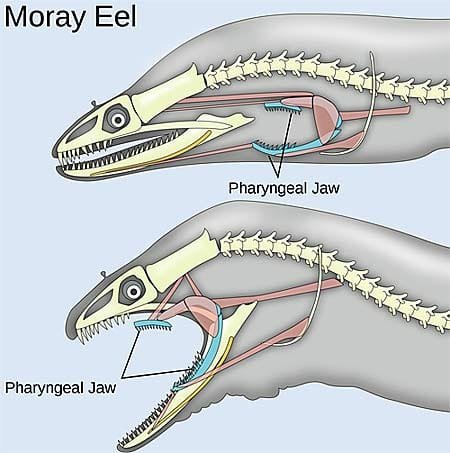
Sci-Fi jaws
Moray eels have a unique and fascinating jaw system. Unlike most fish, which use their main jaws to bite and swallow food, Morays have two sets of jaws. The second set, called pharyngeal jaws is hidden deep inside their throat.
When the Moray bites its prey, the pharyngeal jaws shoot forward into the mouth, grab the prey, and pull it down the throat, like something from a sci-fi movie. This means morays can catch and eat prey with precision and power, even in the dark or in hard-to-reach spots.
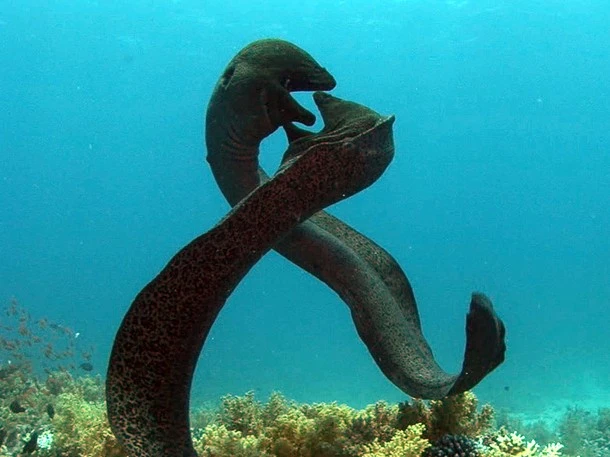
Mating
During mating, a male and female eel may wrap their bodies around each other in a spiraling dance, aligning their vents to release sperm and eggs simultaneously.
Once fertilized, the eggs float freely in the ocean and hatch into tiny, transparent, ribbon-like larvae called leptocephali. These larvae look nothing like adult eels. They’re flat, leaf-shaped, and can drift on ocean currents for up to a year. This long larval stage helps spread Moray eels across wide distances.
Eventually, the larvae change shape into a juvenile Moray eel and settle onto the reef to begin their adult life.
Because of this hidden life cycle and long oceanic stage, Moray eel reproduction is hard to study and not well understood, compared to more common reef fish.
Sex change
Ribbon eels go through a sex change as they grow older. They start life as males and later become females.
When they are young, Ribbon eels are jet black with a yellow dorsal fin. As they grow, they turn bright blue with yellow accents, which means they are now fully developed males.
Later in life, once they get bigger, they change into females, turning mostly yellow, sometimes with bits of blue near the tail.
This change is not just about color. Inside, the eel’s reproductive organs change from male to female. Scientists think this switch happens when the eel reaches a certain size, but we still don’t know exactly what triggers it. Ribbon eels are the only known Moray eels that go through such a dramatic sex and color change during their lives.

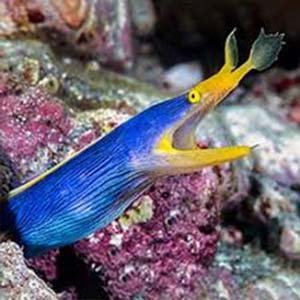
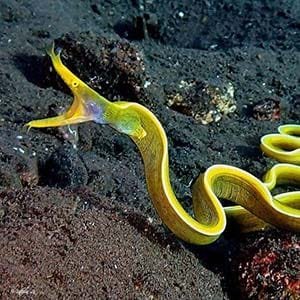
Are Moray eels Dangerous?
Moray eels sometimes get a bad reputation, mainly because of their sharp teeth and fearsome appearance. In truth, moray eel attacks on divers are rare. Most attacks are defensive reactions, not unprovoked aggression.
Some attacks have happened when divers try to hand-feed moray eels. Since they rely heavily on smell, not sight, the eel may accidentally bite the hand instead of the food. Some divers have even lost fingers this way.
Some species, like the Giant Moray, have powerful jaws and can cause serious injury if mishandled. But under normal diving conditions, Morays will simply watch you pass by, or retreat deeper into their hiding spot.
Vital for the reef
Moray eels play a vital role in maintaining the health and balance of coral reefs. As top-level predators, they help control populations of smaller fish, and crustaceans, which in turn prevents overgrazing or overpopulation of certain species. This predator-prey balance is essential to the overall diversity and stability of the reef.
Moray eels deserve more love
At many dive sites around Southeast Asia, moray eels are a common sight. Though they may not be as colorful as Clownfish or as graceful as Manta Rays, Moray eels are some of the reef’s most fascinating residents. Their unique appearance, intelligent hunting techniques, and surprising anatomy make them some of the ocean’s most interesting and mysterious hunters.

